PRINCETON, NJ -- Even as Americans' support for legalizing marijuana has doubled, and more than 20 states have loosened marijuana restrictions in various ways, Gallup finds relatively little increase throughout the past three decades in the percentage of U.S. adults who say they have tried marijuana. Thirty-eight percent of Americans admit to having tried marijuana, compared with 34% in 1999 and 33% in 1985.
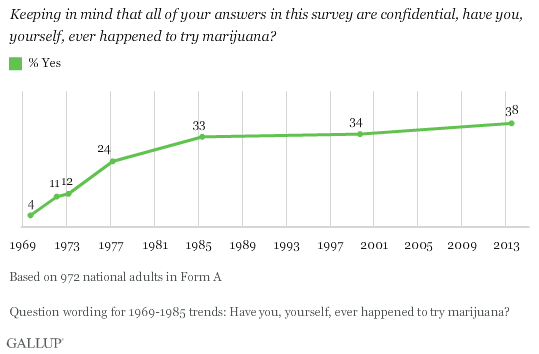
The latest results are from Gallup's annual Consumption Habits poll, conducted July 10-14.
Before Americans' self-reported experimentation with marijuana leveled off in the 1980s, it surged in the 1970s, rising from 4% in 1969 to 12% in 1973 and 24% in 1977.
Gallup's trend by age reveals that widespread experimentation with marijuana first occurred among adults aged 18 to 29 between 1969 and 1973, rising from 8% to 35%. It then continued to mount, reaching 56% by 1977, and remained at that level in 1985. Since then, however, marijuana use among young adults has progressively declined. At the same time, as the bulge of young adults who tried marijuana in the 1970s ages and replaces older Americans who never tried it, the rate of all Americans who have ever tried the drug has increased slightly.
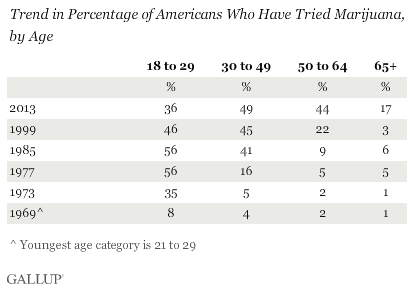
Although more than one-third of American adults have tried marijuana, a much smaller percentage admit to currently using it. Seven percent of U.S. adults in the July 10-14 survey -- a separate half-sample from the one asked if they have ever tried it -- say they smoke marijuana.
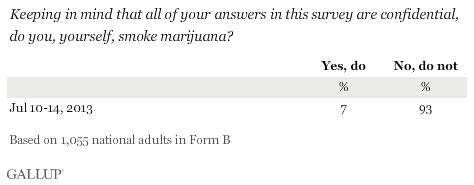
Middle-Aged the Most Experienced With Pot; Young Adults the Biggest Users
Americans' use of marijuana differs greatly by gender, age, and political ideology. However, the demographic patterns for Americans' past experimentation with marijuana and current use are not always the same.
In particular, adults between the ages of 30 and 64 are the most likely age group to say they have tried marijuana, while young adults aged 18 to 29 are the most likely to indicate they currently smoke it. Also, by 47% to 30%, men are more likely than women to say they have tried the drug. However, there is less of a gender difference in current reported usage, with 8% of men and 6% of women saying they smoke pot.
Liberals (13%) have one of the highest rates of self-reported current usage of marijuana, exceeding both moderates (8%) and conservatives (2%). And the pattern is the same for having ever tried it: More liberals (49%) have tried marijuana than moderates (40%) and conservatives (32%).
Experience with marijuana, both past and present, is similar among Democrats and independents, and is more prevalent among both of these groups than it is among Republicans.
There are relatively minor differences in marijuana use by race -- between whites and nonwhites -- and by education. There are no income-related differences among those who say they have tried marijuana, but lower-income Americans are the most likely to say they currently use it. This is consistent with the higher percentage of young adults who say they smoke it, given young adults report relatively lower household income figures.
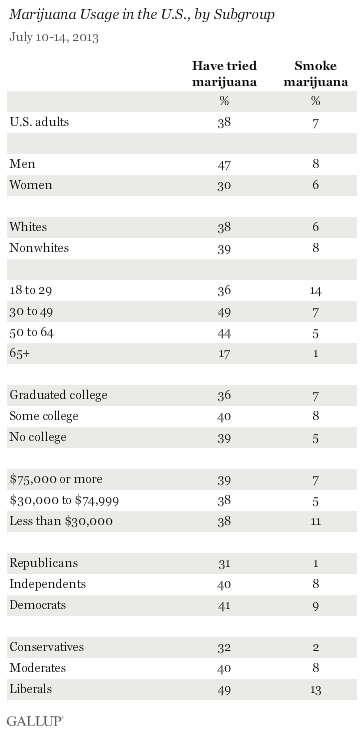
Additionally, U.S. adults who smoke cigarettes are twice as likely as nonsmokers to say they have tried marijuana (65% vs. 32%, respectively), and they are also somewhat more likely to say they smoke marijuana today (10% vs. 6%).
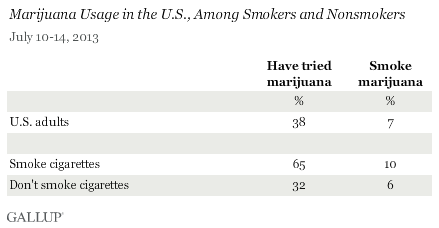
Bottom Line
Americans' support for legalizing marijuana has grown markedly in the past two decades, possibly aided by strong medical-marijuana movements in some states. While this might leave the impression that increasing numbers of Americans are using marijuana recreationally, Gallup finds no such surge in Americans' self-reported experience with the drug. In fact, the percentage of young adults trying marijuana has declined since 1985.
While Gallup has not previously asked Americans if they currently smoke marijuana, the percentage saying they do (7%) is quite low, on an absolute basis. More significantly, the 38% saying they have tried pot is up only four points over Gallup's last measurement in 1999, indicating that the upward momentum that marijuana usage apparently experienced in the 1970s has tapered off considerably. The generational patterns suggest that the total rate of Americans who have ever tried marijuana will continue to increase as the population ages -- but unless young adults' interest in marijuana picks up again, the total rate will eventually decline when those who may have dabbled with the drug in the 1970s and 1980s are gone.
Survey Methods
Results for this Gallup poll are based on telephone interviews conducted July 10-14, 2013, with a random sample of 2,027 adults, aged 18 and older, living in all 50 U.S. states and the District of Columbia.
For results based on the total sample of national adults, one can say with 95% confidence that the margin of sampling error is ±3 percentage points.
For results based on the samples of 972 national adults in Form A and 1,055 national adults in Form B, the margin of sampling error is ±4 percentage points.
Interviews are conducted with respondents on landline telephones and cellular phones, with interviews conducted in Spanish for respondents who are primarily Spanish-speaking. Each sample of national adults includes a minimum quota of 50% cellphone respondents and 50% landline respondents, with additional minimum quotas by region. Landline and cellphone numbers are selected using random-digit-dial methods. Landline respondents are chosen at random within each household on the basis of which member had the most recent birthday.
Samples are weighted to correct for unequal selection probability, nonresponse, and double coverage of landline and cell users in the two sampling frames. They are also weighted to match the national demographics of gender, age, race, Hispanic ethnicity, education, region, population density, and phone status (cellphone only/landline only/both, and cellphone mostly). Demographic weighting targets are based on the March 2012 Current Population Survey figures for the aged 18 and older U.S. population. Phone status targets are based on the July-December 2011 National Health Interview Survey. Population density targets are based on the 2010 census. All reported margins of sampling error include the computed design effects for weighting.
In addition to sampling error, question wording and practical difficulties in conducting surveys can introduce error or bias into the findings of public opinion polls.
View methodology, full question results, and trend data.
For more details on Gallup's polling methodology, visit www.gallup.com.
